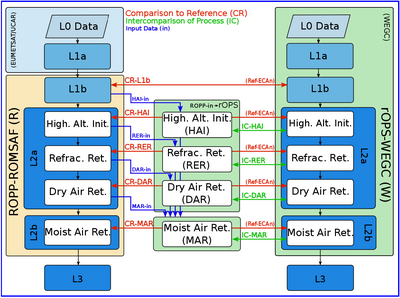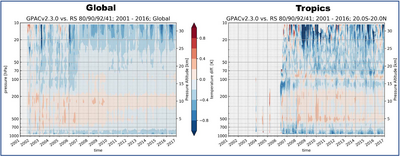ATROMSAF1
Project name: | ATROMSAF1 – Austrian Federated Activity with the EUMETSAT ROM SAF Consortium during the CDOP-3 First-half Period |
Project leader: | Gottfried Kirchengast |
Projekt team: | Marc Schwärz (Project Manager, Senior Scientist) Florian Ladstädter (Postdoc Scientist) Veronika Proschek (Postdoc Scientist) Christian Pock (Scientist Adviser) Jakob Schwarz (Scientist Adviser) Andrea Steiner (Senior Scientist Adviser) |
Partners: | EUMETSAT Radio Occultation Meteorology Satellite Application Facility (ROM SAF) – Danish Meteorological Institute (DMI), Copenhagen, DK; Federated Activity Partners |
Sponsor: | FFG-ALR (Österr. Forschungsförderungsgesellschaft, Agentur für Luft- und Raumfahrt); ASAP-13 (Austrian Space Applications Programme 13th Call) |
Duration: | Mar. 2017 – May 2019 |
Abstract:
At the Wegener Center we employ the unique SI-traceable data from GNSS radio occultation (RO) to monitor the fundamental thermodynamic state of the atmosphere as determined by air density, pressure, temperature, and tropospheric water vapor. These are fundamental variables for tracking climate change and in fact fundamental to all weather and climate processes. Since 2013 the Wegener Center, supported by international partners, developed the new Reference Occultation Processing System rOPS. The rOPS implements SI-traceable atmospheric profiling by RO with integrated uncertainty propagation, to provide benchmark-quality reference RO data for calibration/validation and climate research, complementary to near-real-time data for weather prediction.
The Radio Occultation Meteorology Satellite Application Facility (ROM SAF), part of the SAF Network of EUMETSAT and over 2017-2021 in its Continuous Development and Operations Phase 3 (CDOP-3), generates operational RO data for assimilation into numerical weather prediction systems, re-processed climate data records, a software package for RO processing (ROPP) and weather prediction applications, as well as performs operational monitoring of RO data streams. Its research and development activities are primarily geared towards developing new GNSS RO data products and improving existing products.
With the ATROMSAF1 project the Wegener Center and ROM SAF now joined forces and entered a phase of intensified R&D partnership via a Federated Activity under CDOP-3, aiming to foster high-quality RO data processing and climate applications. The overall aim was to analyze and improve the quantification and understanding of structural uncertainty in RO Level 2 processing from cross-evaluation of Wegener Center’s rOPS and ROM SAF’s ROPP data products as well as to understand the level of consistency, and potential remaining inconsistencies, in long-term climate data records.
This overall aim was worked on and achieved along two specific project objectives as follows:
1) Cross-evaluation between rOPS and ROPP Level 2 data products from bending angles (L2a processing input) towards atmospheric profiles (L2b processing output), for close analysis of L2a structural uncertainty, including one dedicated focus on non-spherical effects, and close linkage of L2b error covariance specifications plus initial ROPP L2b processing analysis, benefitting from the explicit co-estimation of uncertainties by the rOPS;
2) Consistency evaluation of ROPP re-processing climate data records over 2001 to 2016 by using Wegener Center’s RO data as well as independent validation datasets (passive infrared limb-sounder data from MIPAS and SABER and high-quality Vaisala radiosonde data), with a focus to identify, assess, understand and potentially mitigate remaining inconsistencies.
Figures 1 and 2 below illustrate the processing systems used and example results of the work.
Overall the ATROMSAF1 project, which was complemented by EUMETSAT Visiting Scientist activities on correction of residual ionospheric errors and on improving Level 2b processor interlinkage between rOPS and ROPP, was of substantial benefit both for improving ROM SAF’s data products and ROPP usage as well as Wegener Center’s rOPS towards further enhanced uncertainty quantification and reliability of its reference RO data. The results achieved also facilitated the preparation and follow-on proposal success for continuing as of 2020 with the ATROMSAF2 project as another joint Federated Activity for advancing RO and its weather and climate applications.
Figure 1. ROM SAF’s ROPP and Wegener Center’s rOPS input/output data flows were tightly coupled for the purpose of the ATROMSAF1 structural uncertainty studies, illustrated here for the setup of the Level 2a uncertainty analysis that enabled step-by-step quantification and insights from bending angle to atmospheric profile data levels. (Source: Schwärz et al., Wegener Center, 2019)
Figure 2. A validation of ROM SAF’s RO-derived temperature climate data record 2001-2016 (GPAC) with Wegener Center’s radiosonde (RS) record over the troposphere and lower stratosphere indicates both the general high quality of the RO record and remaining small inconsistencies of the datasets that provide valuable insight to detailed properties. (Source: Schwärz et al., Wegener Center, 2019)









